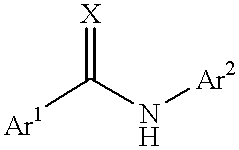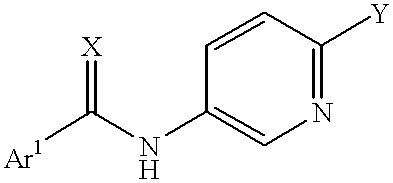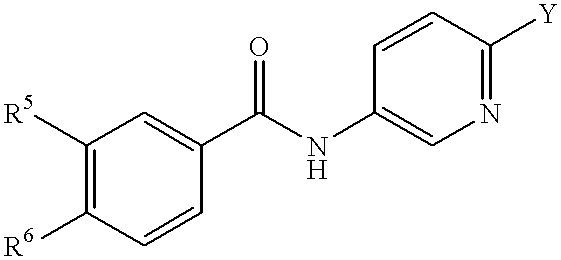Methods for treating or preventing pain and anxiety
a technology of pain and anxiety, applied in the field of pain and anxiety treatment or prevention, can solve the problems that none of the known benzanilide analogues are disclosed to open the potassium channel or to be of us
- Summary
- Abstract
- Description
- Claims
- Application Information
AI Technical Summary
Problems solved by technology
Method used
Image
Examples
example 1
Expression of KCNQ2 and KCNQ3 mRNA in Human Dorsal Root Ganglion
[0140] Expression of KCNQ2 and KCNQ3 mRNA was detected by PCR amplification of human dorsal root ganglion (DRG) cDNA. cDNA was prepared by reverse transcription of total RNA from human DRG using standard procedures. A second mock reverse-transcription reaction was also performed, which was identical to the first, except for the omission of the reverse transcriptase. 35 cycles of amplification were performed on a single microliter of human DRG cDNA, using oligonucleotide primers designed to amplify either KCNQ2 or KCNQ3.
[0141] For KCNQ2, the oligonucleotides used for the amplification were: 5'-GGCTCGGTCCCCCACAGTCAG-3' (sense) and 5'-CTCCACGGCAGGTCCAAGTCTCA-3' (antisense).
[0142] For KCNQ3, the oligonucleotides were: 5'-GCCCACGGTCCTGCCTATCTT-3' (sense) and 5'-CATTGGTGTCCCCGCTGGTAA-3' (antisense).
[0143] PCR amplified DNA fragments were separated by agarose gel electrophoresis, visualized using ethidium bromide staining and ...
example 2
Expression of Recombinant KCNO2 / 3 Channel CHO Cells
[0144] A cloned KCNQ2 / 3 channel was expressed in chinese hamster ovary cells (CHO-K1 cells) according to standard methodology. CHO-K1 cells were transfected with human KCNQ2 / 3 nucleic acid using lipofectamine reagent according to the manufacturer's instructions. Cells stably expressing KCNQ2 / 3 were identified by their resistance to G418 (400 .mu.g / ml). CHO-K1 cells stably transfected with the KCNQ2 / 3 tandem construct were maintained in Ham's F-12 supplemented with 10% heat-inactivated fetal bovine serum and 400 .mu.g / ml G418 in an incubator at 37.degree. C. with a humidified atmosphere of 5% CO.sub.2.
[0145] For modulation of KCNQ channels, a benzanilide KCNQ channel opener was applied to the cells. The compound increased holding current at 40 mV (see FIG. 2) and hyperpolarized the membrane potential.
example 3
Expression of Endogenous KCNO2 / 3 Channel in DRGs
[0146] DRGs were isolated from 1 day old Sprague-Dawley rats. DRGs were dissociated using trypsin (0.25%) and protease type XXIII (2 mg / ml) and neurons were maintained in culture in 90% Eagles MEM (without L-glutamate), 10% FCS, 100 U / m; penicillin, 100 g / ml streptomycin, in an incubator at 37.degree. C. with a humidified atmosphere of 5% CO.sub.2.
[0147] As described above, a benzanilide KCNQ channel opener was applied to the cells. The opener increased holding current at -30 mV and hyperpolarized the membrane potential (see FIG. 3).
PUM
| Property | Measurement | Unit |
|---|---|---|
| membrane potential | aaaaa | aaaaa |
| temperature | aaaaa | aaaaa |
| resting membrane potential | aaaaa | aaaaa |
Abstract
Description
Claims
Application Information
 Login to View More
Login to View More - R&D
- Intellectual Property
- Life Sciences
- Materials
- Tech Scout
- Unparalleled Data Quality
- Higher Quality Content
- 60% Fewer Hallucinations
Browse by: Latest US Patents, China's latest patents, Technical Efficacy Thesaurus, Application Domain, Technology Topic, Popular Technical Reports.
© 2025 PatSnap. All rights reserved.Legal|Privacy policy|Modern Slavery Act Transparency Statement|Sitemap|About US| Contact US: help@patsnap.com



